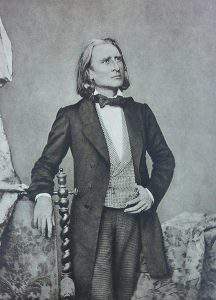Ferenc Liszt, the first pop star?
Index.hu believes that in the world of pop music industry full of “celebrity factories” it’s hard to imagine that it wasn’t the beat era that brought about the first star musicians. Based on the agreement between music historians, the first pop idol appeared in the 1840s, and he was a Hungarian composer and pianist. Some people believe that Ferenc Liszt was the Elvis Presley of the 19th century and that, until Beatles, no one was surrounded with such a euphoric fan cult like he was. Most contemporary sources confirm this opinion.
Ferenc Liszt was born in 1811, the year of the Great Comet, in Doborján (today Raiding in Burgenland) and he was kept count of as a wonder child, just like Mozart. His father, Ádám Liszt enrolled him to piano classes at the age of 7. His talent was acknowledged by Carl Czerny, Antonia Salieri and Beethoven at the age of 10, and he already gave concerts in Paris and London at the age of 12.
The virtuoso pianist and brilliant composer didn’t only become one of the best contemporary composers of the time (Wagner, Chopin, Berlioz ) as a young man, but he also became an idol among the audience, especially women. This was partly due to the image that he consciously created: the handsome young man didn’t pull his punches on the stage, he smoked cigarettes during his performances, passionately whipped his medium-long hair, his instrument sometimes suffered his dramatically ecstatic style.

Between 1839 and 1847 he toured around Europe. His full-house piano shows were visited by many women, who were enchanted by the handsome and charismatic musician. According to contemporary reports, some of them even swooned as soon as he appeared on the stage. Women fought for his gloves, handkerchiefs and cigarette stubs.
His fans threw scarves, jewellery onto the stage after he finished performing. They tried to follow him everywhere; those who managed to get close to him tried to cut off a strand of his hair so that they could put it into a pendant and wear it as a necklace. His portrait was worn on brooches, cameos, like people wear the pins of famous bands nowadays.

The feverish “fan atmosphere” was first reported about in 1840, after a concert in Berlin, which became so iconic that three years later German writer Heinrich Heine created the word Lisztomania to describe the intense fan frenzy. He first used the expression in a gloss published on the 25th of April, 1844 while reporting on the Parisian concert season. He wrote:
“When I first heard about the fainting in Germany, especially Berlin, I shrugged my shoulders regretfully (…) I thought it was only an autotelic hype. This is how I explained Lisztomania and thought of it as one of the signs of political suppression past Rhine. I was wrong, even though I only realised this last week, when Liszt first performed in the Italian Opera House. The audience had nothing to do with the German sentimentalism, but the genius Liszt stood in front of them and still enchanted them. And what frenzied burst of applause was he welcomed with! What an ovation! True madness, which has never been described before in the year books of excitement!”

However, music researchers call our attention to the fact that the expression Lisztomania was much stronger and less good-sounding in that time than the Beatlemania in the 1960-70s. The reason behind this is that it was way before the birth of medical psychology, when the word “mania” was used to describe serious psychiatric diseases, not caprices. This is why Lisztomania was thought of as an infectious disease by many, who proposed suggestions to stop the spread of “the Liszt fever”.
Photos: Wiki Commons
Ce: bm
Source: http://index.hu/
please make a donation here
Hot news
Minister: Hungary will protect its territory by every means possible
Orbán cabinet may double airspace fee: another ticket price increase?
Hungary expanding the list of prohibited designer drugs
Hungarian minister: Ukraine ‘blackmailing’ Hungary and pro-peace states
Cocaine found on a Greek bus at southern border of Hungary
NCIS star arrived in Budapest: spin-off filming started




